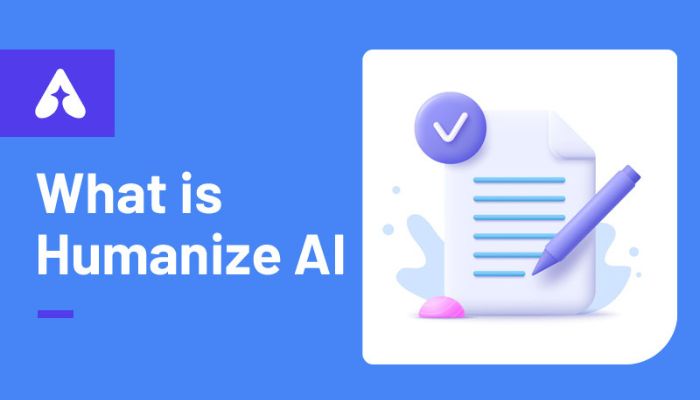Learn about Is Humanize AI Good. Humanize AI enhances the readability and engagement of AI content but suffers from accuracy problems. Read about its advantages, disadvantages, and comparisons.
Introduction
Humanization imbues a thing with human-like qualities, naturalness, or realism, especially in instances where one is referring to an AI or technology application. Humanization is about imbuing the tech with capabilities such as empathy, conversational voice, and emotional intelligence for an enhanced interaction experience. Doing so enhances the user’s experience and makes communication through anything AI feel more ready, interactive, and reliable for its human users.
What is Humanize AI?
Humanize AI is an application that is used to translate text written by AI into a more human-sounding document. It eliminates stiff phrasing, makes writing more readable, and adapts tone to suit human styles of writing. It is ideal for AI-written articles, promotional content, and auto-generated messages requiring more natural handling.
Is Humanize AI Good?
Of course, humanizing AI is great, as it can only improve user experience by making it feel more natural and closer to what people might expect. It enhances communication, builds trust, and adds to the interaction. However, too much humanization might raise some ethical questions concerning deception or creating unrealistic expectations. A balance must be struck to ensure AI remains useful while still being transparent about its artificiality.
Why is AI-generated content Popular?
Efficiency and scalability are the two main reasons propelling the popularity of AI content generation. These include:
Speed
AI authorship can put out thousands of words in a matter of seconds, thereby drastically minimizing the time spent in content creation. Businesses can generate tons of content in a matter of days, thus meeting their deadlines and staying true to their publishing schedules while avoiding delays familiar to human-written content.
Cost-Effective
AI content creation lessens the dependence on human labor and, therefore, labor costs. Henceforth, following the logic, businesses may find allocating capital more workable so that bulk generation can be contracted out to AI while human efforts are focused on creativity, strategy, and high-value writing tasks requiring in-depth analysis.
SEO Optimization
AI software can automatically integrate keywords to improve ranking. They analyze current trends and user intents so that the content is optimized for SEO best practices. With increased visibility, such traffic is directed toward the website; at the same time, AI makes sure that the content remains readable and relevant for users.
Consistency
AI provides a consistent tone and style for several content pieces. This is especially helpful for brands that need consistent messaging. With the same style of writing, AI assists companies in building a strong and recognizable brand voice on different platforms.

Methods to Humanize AI-Generated Content
To make AI content sound more natural, consider these techniques:
- Rewrite sentences with a conversational tone.
- Use contractions (e.g., “it’s” instead of “it is”).
- Add rhetorical questions to engage readers.
- Break long paragraphs into shorter, digestible chunks.
- Include relatable analogies or metaphors.
- Inject emotions and personal opinions.
Does Humanizing AI Improve SEO?
Yes, yet it attaches to a certain extent, actually. Good and humanized AI contents have good rank generally.
- Uses natural language
- Avoids keyword stuffing
- Provides valuable insights
- Engages readers effectively
Humanized AI vs. Human-Written Content
Humanized AI
AI produces content rapidly, and it is affordable and SEO-friendly. It promotes efficiency and consistency in all platforms. Nevertheless, it tends to lack profound creativity, originality, and emotional subtleties, which restrict its capacity to create highly engaging and stimulating stories.
✅ Faster production
✅ Cost-effective
✅ SEO-friendly
❌ Lacks deep creativity
Human-Written
Human authors offer original views, emotional depth, and improved storytelling. They develop engaging stories that readers can relate to. But this is a labor-intensive process that demands more resources and time. It is therefore less scalable than that of AI content.
✅ Unique perspectives
✅ More emotional depth
✅ Better storytelling
❌ Time-consuming
Drawbacks of Humanize AI
1. Accuracy Issues
Their AI could compromise the accuracy and introduce factually wrong information, which changes to sound more natural but distorts meaning. This distortion will severely reduce fidelity to the content, which needs highly important and correct proof.
2. Over-Humanization
Too much humanization can make the AI text appear confused or casual. This creates misleading interpretations, directly affecting professionalism in technical writing, academic work, and business reports requiring clarity, coherence, and formality.
3. Limited Creativity
Human-like AI generally struggling with true creativity often ends up remixing available content instead of churning new ideas, particularly concerning human intuition, emotional depth, and inimitable expressions that are required for storytelling or artistic work.
4. Dependence on AI Detection Trends
With the evolution of AI detection, humanization strategies will need to be constantly renewed. Because of this dependency, it can lead to a kind of inefficiency in workload requiring constant changes to avoid detection tools and, ultimately, create inconsistencies in AI-assisted writing.
How Does Humanize AI Compare to Other Tools?
There are numerous such tools: QuillBot, Grammarly, Jasper AI, etc. Here’s how Humanize AI is ahead of the pack.
QuillBot
Paraphrasing and rewording throughout QuillBot excel humanization, yet much lack of deep contextual humanization. Readability is okay, but QuillBot cannot completely develop the nuances of human writing; therefore, it may not be effective in bypassing AI detection.
Grammarly
Grammarly is mainly concerned with grammar, spelling, and style improvement. It enhances readability and clarity but does not have features that are specifically aimed at humanizing AI-generated content, so it is not as good at evading AI detection.
Jasper AI
Jasper AI writes in a human-like manner but lacks a specific AI humanization feature. It tries to produce content from scratch more than tweaking AI-written content to be more natural and unremarkable.
Conclusion
Humanize AI is a helpful tool in refining any AI-generated content; however, it does come with its limitations. While it does contribute to the improvement of readability and engagement, it may not preserve the exact meaning every time. Manual editing should always be put into the mix so that quality is preserved. All-in-all, a great tool for content creators, marketers, and businesses dealing in text improvement.






